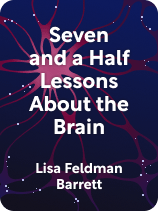

This article is an excerpt from the Shortform book guide to "Seven and a Half Lessons About the Brain" by Lisa Feldman Barrett. Shortform has the world's best summaries and analyses of books you should be reading.
Like this article? Sign up for a free trial here.
Do you understand human brain development? How does the brain develop?
In Seven and a Half Lessons About the Brain, Lisa Feldman Barrett explains how everyone’s brain develops differently, based on a combination of their genes and their environment. Human brain development depends on the interaction between the genetic information already present in the brain and the environment it develops in.
Continue reading to learn how this interaction has great implications for the development of children’s brains.
The Brain Needs Lots of Help to Develop Successfully
Barrett explains that after birth, a baby’s brain develops according to its genetic coding and the physical and social environment. Genes help develop the basic infrastructure of the brain while environmental input triggers brain plasticity to develop certain neural connections more or less strongly.
Barrett identifies two specific processes that take place in the newborn’s brain as genes and the environment interact and help human brain development:
- Tuning: Important connections between neurons get stronger the more they’re used or the more essential they are for energy budgeting. For example, the baby learns to suck on a bottle or her mother’s breast very quickly because it’s a crucial energy budgeting task that she repeats several times a day. (Shortform note: Babies are born with roughly 100 neurons, and during their first year of life, babies’ brains generate more than a million new neural connections each second.)
- Pruning: Unnecessary connections are dismantled to make room for more important ones. For example, babies are born with connections to help them identify a wider variety of flavors than adults, but over time most of those connections are lost to prioritize the ones that help them distinguish flavors they’re more commonly exposed to. (Shortform note: This process of synaptic pruning happens when a child is about six years old.)
(Shortform note: Compared to other animals, a human baby’s brain is woefully unprepared for the world—for example, while other animals can almost immediately start walking, the human brain remains fetus-like for at least two years. Babies are born with immature brains because a full-grown human brain would not make it through the birth canal. As a result, babies rely on their environment to help complete their development. Scientists argue that this fosters human intelligence because human adults need to care for the survival of helpless members of their families, which makes their own brains develop uniquely human skills of survival.)
According to Barrett, the environment—especially the quality of the baby’s caregivers—is essential during this process. While the baby’s brain is developing, caregivers perform energy budgeting tasks for them, such as feeding them, helping them sleep, and comforting them when they’re distressed. This allows the brain to spend more energy tuning and pruning. Conversely, children who don’t receive adequate physical and social support from their environment have difficulties developing their brains. This happens in situations where there is poverty or neglect, for example.
Crucial Tasks of a Caregiver
It might be overwhelming for parents or caregivers to consider the responsibility they have in shaping a child’s brain. But child development specialists suggest focusing on three key tasks (after meeting the child’s needs for food, sleep, and comfort):
- Encourage the child’s innate curiosity by paying attention to what catches their interest and helping them explore and learn about the world.
- Understanding the stages of development a child will go through to give them the kind of stimulus they will benefit from at each stage.
- Helping the child learn to manage anxiety and stress—both of which place a heavy load on their energy budgets.
Brains Develop Into Unique Minds
Although our brains (physical organs) share a basic architecture, each one gets tuned and pruned according to its environment, producing widely different minds (individual patterns of thought and action). This is similar to the way two college students might buy the same laptop with the same basic capabilities (brain), but they each load certain programs onto their laptops (and delete others) based on what they are studying (since their needs and culture will be different). One student might have more money and more expensive software and accessories, while the other might use the free or cheap ones (since their conditions and environment will vary as well). As a result, the two computers will appear very different once you boot them up, just like our minds.
Barrett claims that this capacity for brain variation is the result of our brain’s plasticity and complexity, as neurons and neural clusters change to meet environmental needs. This flexibility makes humans adaptable to different environments, aiding in our evolution and survival as a species. As individuals, it also allows us to alter our minds by exposing ourselves to new stimuli and learning intentionally.
(Shortform note: Evolution might help explain why the same human brain can produce a wide range of different minds. As Barrett says, brain variation helps our species’ survival. In fact, evolutionary biologists argue that each type of personality has distinct evolutionary benefits that allow humans to survive and thrive in specific situations. For example, extroverted minds are often more successful at finding a mate, while introverted minds are often more successful at creating stable families. Minds with neurotic tendencies are especially adept at detecting dangers, while agreeable minds are especially adept at picking up on the emotional states of others and creating harmony within a community.)

———End of Preview———
Like what you just read? Read the rest of the world's best book summary and analysis of Lisa Feldman Barrett's "Seven and a Half Lessons About the Brain" at Shortform.
Here's what you'll find in our full Seven and a Half Lessons About the Brain summary:
- How the human brain develops and operates
- Why the brain isn't organized in the way you thought it was
- How brains collaborate with one another






